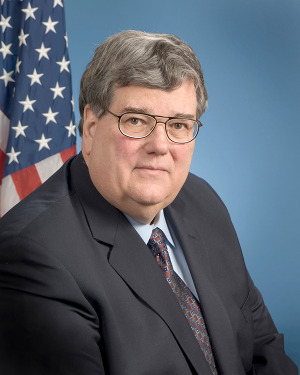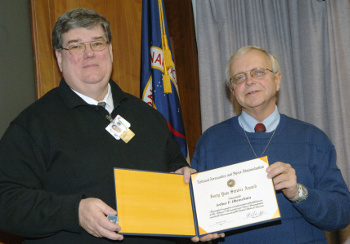 |
| May 05, 2015 | Volume 11 Issue 17 |
Designfax weekly eMagazine
Archives
Partners
Manufacturing Center
Product Spotlight
Modern Applications News
Metalworking Ideas For
Today's Job Shops
Tooling and Production
Strategies for large
metalworking plants
Advice from a NASA boss: How an intern became Deputy Center Director
By Ashley Morrow, NASA's Goddard Space Flight Center

Rick Obenschain official portrait. [Image Credit: NASA Goddard/Pat Izzo]
"It actually proved a blessing that I wasn't very bright," said Rick Obenschain, looking back at his 50-year career at NASA's Goddard Space Flight Center in Greenbelt, MD.
It sounds like the punchline to an odd joke, but Obenschain means it. Officially retired on March 31, he was deputy center director at Goddard since 2007.
"We'll miss Rick's mentorship and leadership," Center Director Chris Scolese said. "He is too humble to say so himself, but his intense dedication and ability to tackle hard problems have benefitted Goddard, NASA, and the nation for over 50 years."
Obenschain attributes his career to luck, chances given, and learning from his mistakes. When he had the opportunity in college to work at the center, Obenschain said he jumped at the chance. He began as a summer engineering aide in 1962 just after the center's third anniversary. During that first summer, the majority of Goddard employees, Obenschain included, were not even on location at the center in Greenbelt.
Obenschain transferred from an off-site office to the center's main campus in the summer of 1963. He was given a seat in Building 20, then intended to be a warehouse. Center leadership had converted it to offices in an effort to house Goddard's expanding workforce.
"The walls only came up six or eight feet," Obenschain said. "It was all open grid-work on the top. Birds would get in. Birds would fly over your head. It was very, very different."
Obenschain said there would have been no chance of him getting a job at NASA if he hadn't worked as an engineering aide those summers in the warehouse. "There wouldn't have been a prayer," he said.
But someone took a chance on him. He joined in the palpable excitement at Goddard in the 1960s.
Obenschain worked with a team that put together a satellite in record time. "We went around the center," he said. "We found some solar arrays, and we put together a satellite in 90 days using stuff you could essentially find in your junk box. Then we sent it to the launch site. Even as a very junior observer, I could see what amazing work was being accomplished by a group of folks who didn't understand 'can't.'"
The spacecraft was Package Attitude Control-A launched in 1969 to determine if a Delta rocket could be stabilized at the second stage to become a platform for another mission.
"We didn't know what we didn't know, so we were willing to do anything," he said.
In the early days of space exploration, NASA did make some mistakes, which was only natural in that brand new field. Employees bounced back from mistakes out of necessity, learning as much as they could before moving on.
That resilience has followed Obenschain through the years.
Early in his career, the "NASA pioneers" -- those people who started with the agency in 1958 -- looked out for him, guided him, and helped him learn from his mistakes, Obenschain said.
Obenschain considers asking questions and maintaining a healthy sense of curiosity the best way to learn.
"The second is to raise your hand a lot," he said. "When problems would come up, someone would be saying, 'I need somebody to ...' and then they'd say, 'Rick, put your hand down. I haven't even finished the question yet.'"
Over the years, he learned to ask the right questions and came to be known as a problem solver. That reputation followed him through five project management roles, including a stint in the early 1990s on the Geostationary Operational Environmental Satellite project, known as GOES, during a troubled period.
"A terrible thing happened in 1990," he said. "Saddam Hussein invaded Kuwait. On the front page of The New York Times, there was a picture of the Iraqi tanks crossing the border. The only other thing above the fold in The Times that day was an article on the left side that said, essentially, the GOES project is a disaster."
Scientists had discovered yet another flaw on the newest GOES instrumentation, which would further delay its launch. This was a project with national importance because of its role in weather and environmental services. A single satellite provided overviews of weather conditions at that time, and U.S. officials feared it would fail before GOES launched, causing a lapse in weather images and data. NASA Headquarters charged John Klineberg, then the center director at Goddard, with finding a new project manager.

Rick Obenschain receives his 40-year service award from then-Goddard Center Director Dr. Ed Weiler in 2005. [Image Credit: NASA Goddard/Debbie McCallum]
Shortly afterward, Klineberg called Obenschain to his office. Obenschain worried he might be fired, thinking he had bantered a bit too much with the center director at a budget meeting. Instead, Klineberg offered him the GOES project manager position. Klineberg didn't even know the new project manager's last name at the time, Obenschain said.
"To be given a project with national importance with 15 months' project management experience because I didn't have enough sense to keep my mouth shut was pretty cool," he said. "You're talking about someone who was really lucky."
From there, Obenschain's career took off. He turned the GOES project around. It launched four years after Obenschain began managing the project and provided critical data for weather forecasting until it was retired in 2004.
Obenschain managed three more projects before entering senior leadership at Goddard as the deputy director of engineering. Within eight years of that, he obtained the deputy center director position, where he served for another seven and a half years.
Being a leader is simpler than people think, he said. "There are only four rules of management and three rules of leadership. That's all you need to guide your path," he said.
Obenschain's Three Rules of Leadership:
- A leader is able to create a vision. People need to know where you're going, how you're doing it, and how you're going to measure if you are making the right progress.
- A leader is able to take people to places they don't want to go.
- A leader ensures everyone who takes the journey is better off in the end.
- A good manager knows the requirements and is able to write them down and explain them to people.
- A good manager knows what their resources are: how much time, how many people, what they can bring to bear.
- A good manager knows when to make a decision. "Most really big decisions have about 100 facts that you need," Obenschain said. "When you have somewhere between 40 and 70, you should make a decision. Any less and you're just shooting wildly. Any more and you're procrastinating."
- A good manager must communicate. They must tell their employees what they're doing, why they're doing it, and include everyone.
"There's one overarching rule," Obenschain said. "Have fun. If work is not the most fun you're having during the week, do something else. I feel so sorry for people who talk about how they've only got 17 more years until retirement."
It's clear that Obenschain has had fun during his years at Goddard. He said he has hundreds of stories about humorous events, such as when then-NASA Deputy Administrator J.R. Thompson asked Klineberg to come to headquarters to discuss the leadership on the GOES project, but Klineberg sent Obenschain instead.
When Obenschain arrived, he said Thompson looked around and asked where Klineberg was.
"When I left," Obenschain said to Thompson, "Klineberg had pulled his desk in front of the door and he was hiding under his chair. I'm not sure why."
Obenschain approached everything in his career with this sense of humor.
But Obenschain dedicated almost his entire career to Goddard because of his immense respect for the agency, the people, and the work. "I'm just so attuned to NASA's mission," he said. "We've had the same mission for 53 years. We answer the questions that inspire."
Obenschain's impact on the center and on NASA as a whole is clear. "He has personally supported hundreds of people in his illustrious career," former Center Director Rob Strain said. "I don't know anyone who has dedicated himself more or made more contributions to the agency than Rick."
Still, it's time to hand over the mission to the next generation, Obenschain said. "I'm looking forward to retirement," he said. "I've had a wonderful career. I was given all these opportunities. Sometimes I failed, sometimes I didn't. I learned from my mistakes, or at least enough of them. Now I'm moving forward."
Following his retirement, Obenschain will move with his wife Georgina to their vacation home in Bethany Beach, DE.
Related link: Rick Obenschain's professional biography
Published May 2015
Rate this article
View our terms of use and privacy policy
